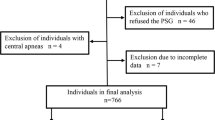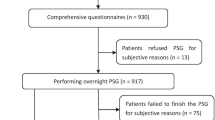Abstract
This study sought to determine whether reduced pulmonary function in obstructive airway disease (OAD) is an independent risk factor for obstructive sleep apnea (OSA). This was a prospective observational study conducted at an outpatient pulmonary clinic. Adults with a known diagnosis of COPD/asthma were enrolled as OAD group. Family members without a history of COPD/asthma who accompanied these patients to the clinic were enrolled as a control group. The Berlin Questionnaire (BQ) was used to assess OSA risk in the OAD group and controls. Forced expiratory volume in 1 second (FEV1 % predicted) was determined from spirometry. The subjects at high risk for OSA were referred for a full overnight polysomnogram (PSG). The prevalence of patients with a high risk of OSA was 55.2% in the OAD group, which was higher than in the controls (7.5%, p < 0.0001). OAD subjects had a higher body mass index (BMI) and larger neck circumference than controls (p < 0.01). There was no difference in FEV1 % predicted between the OAD patients at high risk and low risk of OSA. On receiver operator curve (ROC) analysis, FEV1 % predicted was not a significant predictor of high OSA risk. Using logistic regression, FEV1 % predicted had no association with OSA risk. There was no correlation between FEV1 % predicted and total apnea–hypopnea index (AHI), oxygen desaturation index, % time spent below oxygen saturation 90%, and mean oxygen saturation on multiple regression analysis. OSA appears to be common in patients with COPD or asthma in an urban outpatient pulmonary clinic. However, the high prevalence of OSA in OAD patients appears to be due to obesity, and reduced pulmonary function is not an independent risk factor for OSA.

Similar content being viewed by others
References
Tishler PV, Larkin EK, Schluchter MD, Redline S (2003) Incidence of sleep-disordered breathing in an urban adult population: the relative importance of risk factors in the development of sleep-disordered breathing. JAMA 289:2230–2237
Young T, Peppard PE, Gottlieb DJ (2002) Epidemiology of obstructive sleep apnea: a population health perspective. Am J Respir Crit Care Med 165:1217–1239
Auckley D, Moallem M, Shaman Z, Mustafa M (2008) Findings of a Berlin Questionnaire survey: comparison between patients seen in an asthma clinic versus internal medicine clinic. Sleep Med 9:494–499
Alharbi M, Almutairi A, Alotaibi D, Alotaibi A, Shaikh S, Bahammam AS (2009) The prevalence of asthma in patients with obstructive sleep apnoea. Prim Care Respir J 18:328–330
Julien JY, Martin JG, Ernst P, Olivenstein R, Hamid Q, Lemière C, Pepe C, Naor N, Olha A, Kimoff RJ (2009) Prevalence of obstructive sleep apnea–hypopnea in severe versus moderate asthma. J Allergy Clin Immunol 124:371–376
Yigla M, Tov N, Solomonov A, Rubin AH, Harlev D (2003) Difficult-to-control asthma and obstructive sleep apnea. J Asthma 40:865–871
ten Brinke A, Sterk PJ, Masclee AA, Spinhoven P, Schmidt JT, Zwinderman AH, Rabe KF, Bel EH (2005) Risk factors of frequent exacerbations in difficult-to-treat asthma. Eur Respir J 26:812–818
Ramagopal M, Scharf SM, Roberts DW, Blaisdell CJ (2008) Obstructive sleep apnea and history of asthma in snoring children. Sleep Breath 12:381–392
Flenley DC (1985) Sleep in chronic obstructive lung disease. Clin Chest Med 6:51–61
Guilleminault C, Cummiskey J, Motta J (1980) Chronic obstructive airflow disease and sleep studies. Am Rev Respir Dis 122:397–406
Chaouat A, Weitzenblum E, Krieger J, Ifoundza T, Oswald M, Kessler R (1995) Association of chronic obstructive pulmonary disease and sleep apnea syndrome. Am Rev Respir Dis 151:82–86
Sanders MH, Newman AB, Haggerty CL, for the Sleep Heart Health Study (2003) Sleep and sleep-disordered breathing in adults with predominantly mild obstructive airway disease. Am J Respir Crit Care Med 167:7–14
Bednarek M, Plywaczewski R, Jonczak L, Zielinski J (2005) There is no relationship between chronic obstructive pulmonary disease and obstructive sleep apnea syndrome: a population study. Respiration 72:142–149
Marin JM, Soriano JB, Carrizo SJ, Boldova A, Celli BR (2010) Outcomes in patients with chronic obstructive pulmonary disease and obstructive sleep apnea: the overlap syndrome. Am J Respir Crit Care Med 182:325–331
Netzer NC, Stoohs RA, Netzer CM, Clark K, Strohl KP (1999) Using the Berlin Questionnaire to identify patients at risk for the sleep apnea syndrome. Ann Intern Med 131:485–491
Miller MR, Hankinson J, Brusasco V, ATS/ERS Task Force (2005) Standardisation of spirometry. Eur Respir J 26:319–338
American Academy of Sleep Medicine (2007) AASM Manual for the scoring of sleep and associated events: rules, terminology, and technical specifications. American Academy of Sleep Medicine, Darien, IL
Kinsman RA, Yaroush RA, Fernandez E, Dirks JF, Schocket M, Fukuhara J (1983) Symptoms and experiences in chronic bronchitis and emphysema. Chest 83:755–761
Global Initiative for Asthma (GINA) Scientific Committee (2007) Global strategy for asthma management and prevention. Available at http://www.ginasthma.com/download.asp?intId=411. Accessed 17 Sept 2010
Camargo CA Jr, Weiss ST, Zhang S, Willett WC, Speizer FE (1999) Prospective study of body mass index, weight change, and risk of adult-onset asthma in women. Arch Intern Med 159:2582–2588
Teodorescu M, Consens FB, Bria WF, Coffey MJ, McMorris MS, Weatherwax KJ, Palmisano J, Senger CM, Ye Y, Kalbfleisch JD, Chervin RD (2009) Predictors of habitual snoring and obstructive sleep apnea risk in patients with asthma. Chest 135:1125–1132
Kimoff RJ, Sforza E, Champagne V, Ofiara L, Gendron D (2001) Upper airway sensation in snoring and obstructive sleep apnea. Am J Respir Crit Care Med 164:250–255
Kimoff RJ (2007) Upper airway myopathy is important in the pathophysiology of obstructive sleep apnea. J Clin Sleep Med 3:567–569
Hoffstein V, Zamel N, Phillipson EA (1984) Lung volume dependence of pharyngeal cross-sectional area in patients with obstructive sleep apnea. Am Rev Respir Dis 130:175–178
Author information
Authors and Affiliations
Corresponding author
Rights and permissions
About this article
Cite this article
Sharma, B., Feinsilver, S., Owens, R.L. et al. Obstructive Airway Disease and Obstructive Sleep Apnea: Effect of Pulmonary Function. Lung 189, 37–41 (2011). https://doi.org/10.1007/s00408-010-9270-3
Received:
Accepted:
Published:
Issue Date:
DOI: https://doi.org/10.1007/s00408-010-9270-3




